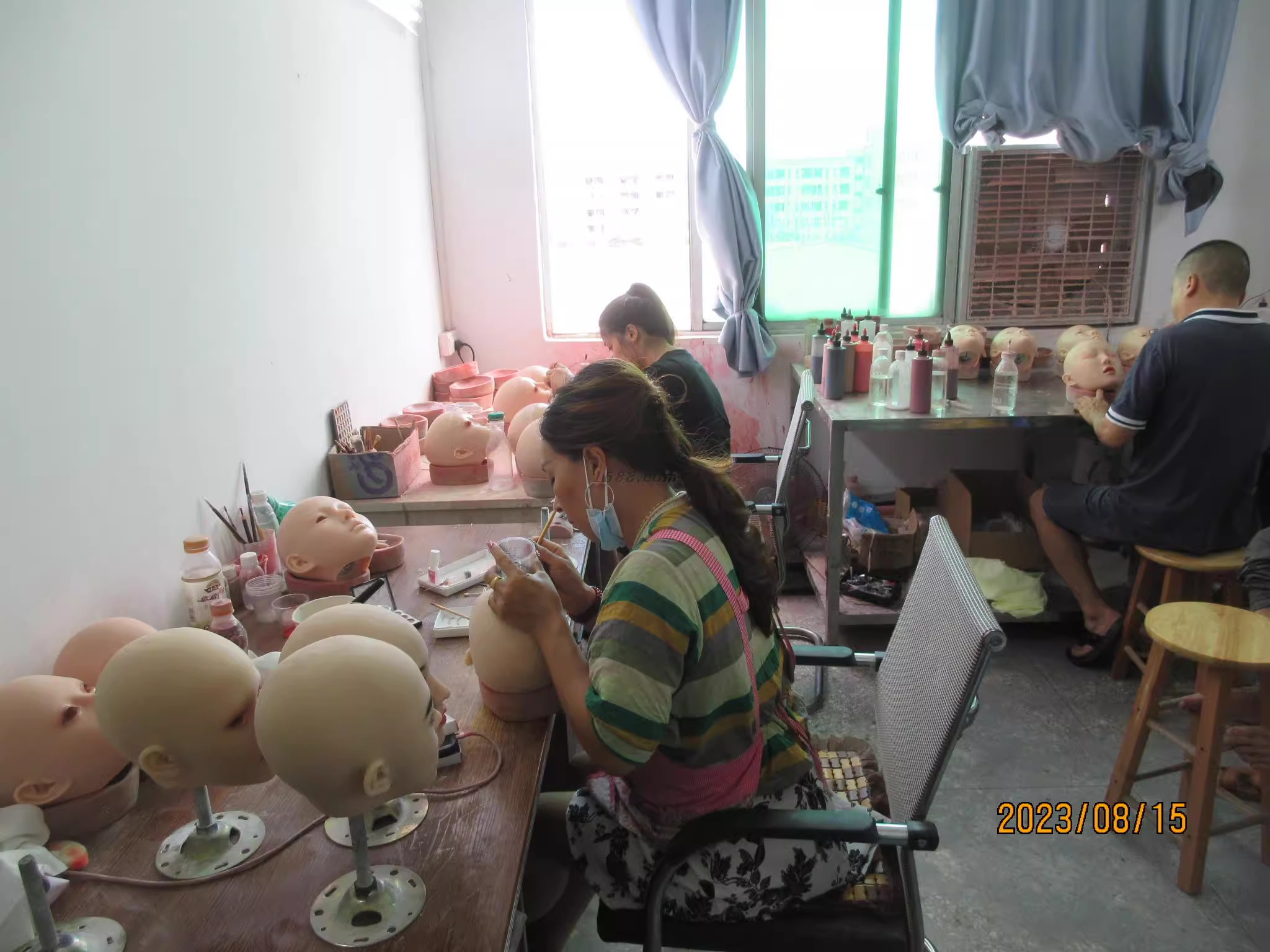Innholdsfortegnelse
Introduksjon
Silicone dolls have gained significant popularity in recent years due to their realistic appearance and durability. As the demand for these lifelike dolls continues to grow, it becomes essential to understand the meticulous production process that goes into creating them. This guide will take you through every step of silicone doll production, from initial design to quality control, highlighting the use of advanced materials and techniques.
1. Understanding Silicone Doll Materials
The foundation of any high-quality silicone doll lies in the materials used. Different types of silicone are employed in the manufacturing process, each with specific properties that contribute to the doll’s overall quality.
Types of Silicone Used in Doll Manufacturing
Silicone used in doll production is typically medical-grade, ensuring it is safe and non-toxic. Medical grade silicone is renowned for its durability, flexibility, and hypoallergenic properties. This type of silicone is also resistant to high temperatures and environmental stress, making it ideal for creating lifelike dolls.

Advantages of High-Quality Silicone
High-quality silicone offers several benefits:
•Realistic Feel and Appearance: Medical grade silicone closely mimics human skin, providing a realistic touch and appearance.
•Varighet: Silicone dolls made from high-quality materials are more resistant to wear and tear, ensuring they last longer.
•Safety: Medical grade silicone is hypoallergenic and safe for prolonged skin contact, making it suitable for intimate products.
2. The Initial Design and Sculpting Process
The journey of creating a silicone doll begins with a detailed design and sculpting process. This stage is crucial in ensuring the final product meets aesthetic and functional standards.
Creating the Initial Mold for the Silicone Doll
The initial mold is the blueprint for the silicone doll. Artists and designers collaborate to create a prototype, often using clay or digital sculpting software. This prototype serves as the master model from which molds are made.

Hand-Sculpting Techniques for Realistic Features
To achieve lifelike features, skilled artisans employ hand-sculpting techniques. This meticulous process involves adding intricate details such as facial expressions, body contours, and texture. The goal is to create a doll that looks and feels as realistic as possible.
3. Mold Preparation and Silicone Pouring
Once the master mold is ready, the next step involves preparing it for silicone pouring. This stage requires precision and attention to detail to ensure a flawless final product.
Preparing the Mold for Silicone Pouring
The mold must be cleaned and treated with a release agent to prevent the silicone from sticking. This preparation is crucial in achieving smooth and bubble-free silicone surfaces.
Techniques for Pouring Silicone to Avoid Air Bubbles
Air bubbles can compromise the integrity of the silicone doll. To avoid this, manufacturers use vacuum chambers to remove air from the silicone mixture before pouring it into the mold. I tillegg, the mold is often vibrated during pouring to help the silicone settle evenly and eliminate any remaining air pockets.

4. Assembly and Customization
After the silicone has cured, the doll components are carefully removed from the molds and assembled. This stage also allows for customization according to client specifications.
Assembling the Silicone Doll Components
The silicone parts, including the head, torso, limbs, and other features, are assembled using medical-grade adhesives. Each component is meticulously attached to ensure the doll’s structural integrity and functionality.
Customizing the Doll According to Client Specifications
Customization is a significant aspect of silicone doll production. Clients can choose from various options, such as hair type, eye color, skin tone, and even body type. This personalization ensures that each doll is unique and tailored to the client’s preferences.

5. Detailing and Finishing Touches
The detailing process involves adding final touches that enhance the doll’s realism. This stage is essential in transforming a silicone model into a lifelike figure.
Adding Realistic Skin Texture and Details
To create realistic skin texture, artisans use specialized tools and techniques. This process involves adding fine lines, pores, and other skin details that mimic human skin. The goal is to achieve a texture that not only looks real but also feels authentic to the touch.
Painting and Finishing Techniques for Lifelike Appearance
Painting is a crucial step in the detailing process. Artisans use high-quality, skin-safe pigments to add color and depth to the doll’s features. This includes blushing the cheeks, shading the body contours, and adding subtle details such as freckles and veins. The finishing touches involve sealing the paint with a protective layer to ensure it remains vibrant and durable.

6. Quality Control and Testing
Quality control is paramount in silicone doll manufacturing. This stage ensures that each doll meets the highest standards of safety and durability.
Quality Control Measures in Silicone Doll Production
•Visual Inspection: Each doll undergoes a thorough visual inspection to check for defects and inconsistencies.
•Durability Testing: Dolls are subjected to stress tests to ensure they can withstand regular use without damage.
•Safety Checks: The materials used are tested to ensure they are non-toxic and hypoallergenic.
Ensuring Durability and Safety of the Dolls
In addition to material testing, manufacturers perform functional tests to ensure the doll’s joints and features work correctly. This includes checking the flexibility of limbs and the stability of the assembled components.

7. Packaging and Shipping
Proper packaging and shipping are essential to maintain the integrity of the silicone dolls during transit.
Safe Packaging Methods for Silicone Dolls
Dolls are carefully packaged using protective materials to prevent damage during shipping. This includes padding and securing the doll in a sturdy box.
Shipping Considerations to Maintain Doll Integrity
Shipping considerations include choosing reliable carriers and using tracking systems to monitor the shipment. Manufacturers also provide detailed care instructions to clients to ensure the dolls are maintained properly after delivery.

Vanlige spørsmål
How long does it take to produce a silicone doll?
The production time for a silicone doll can vary depending on the complexity and level of customization. On average, it takes several weeks to complete the entire process.
What materials are used in the making of silicone dolls?
Silicone dolls are primarily made from medical-grade silicone, known for its safety and durability. Other materials used include medical-grade adhesives and high-quality pigments for painting.
How can I customize my silicone doll?
Clients can customize their silicone dolls by selecting various options such as hair type, eye color, skin tone, and body type. Additional customizations may include specific facial features and body modifications.
What quality control measures are in place?
Allurbe implement stringent quality control measures, including visual inspections, durability testing, and safety checks to ensure each doll meets the highest standards.
How are silicone dolls shipped?
Silicone dolls are packaged using protective materials to prevent damage during transit. Reliable carriers are chosen for shipping, and tracking systems are used to monitor the shipment.
Konklusjon
The production of silicone dolls is a complex and meticulous process that involves multiple stages, from initial design to quality control. Understanding this process highlights the importance of choosing high-quality, hypoallergenic materials and ensuring rigorous standards are met. As the demand for lifelike silicone dolls continues to grow, manufacturers strive to provide products that not only meet but exceed client expectations.




